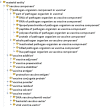Ontology representation and analysis of vaccine formulation and administration and their effects on vaccine immune responses
- PMID: 23256535
- PMCID: PMC3639077
- DOI: 10.1186/2041-1480-3-17
Ontology representation and analysis of vaccine formulation and administration and their effects on vaccine immune responses
Abstract
Background: A vaccine is a processed material that if administered, is able to stimulate an adaptive immune response to prevent or ameliorate a disease. A vaccination process may protect the host against subsequent exposure to an infectious agent and result in reduced disease or total prevention of the disease. Vaccine formulation and administration methods may affect vaccine safety and efficacy significantly.
Results: In this report, the detailed classification and definitions of vaccine components and vaccine administration processes are represented using OWL within the framework of the Vaccine Ontology (VO). Different use cases demonstrate how different vaccine formulations and routes of vaccine administration affect the protection efficacy, general immune responses, and adverse events following vaccination. For example, vaccinations of mice with Brucella abortus vaccine strain RB51 using intraperitoneal or intranasal administration resulted in different protection levels. As shown in the vaccine adverse event data provided by US FDA, live attenuated and nonliving vaccines are usually administered in different routes and have different local and systematic adverse effect manifestations.
Conclusions: Vaccine formulation and administration route can independently or collaboratively affect host response outcomes (positive protective immunity or adverse events) after vaccination. Ontological representation of different vaccine and vaccination factors in these two areas allows better understanding and analysis of the causal effects between different factors and immune responses.
Figures




Similar articles
-
Efficacy of vaccination strategies against intranasal challenge with Brucella abortus in BALB/c mice.Vaccine. 2011 Mar 24;29(15):2749-55. doi: 10.1016/j.vaccine.2011.01.090. Epub 2011 Feb 20. Vaccine. 2011. PMID: 21316499
-
Booster vaccination with safe, modified, live-attenuated mutants of Brucella abortus strain RB51 vaccine confers protective immunity against virulent strains of B. abortus and Brucella canis in BALB/c mice.Microbiology (Reading). 2015 Nov;161(11):2137-48. doi: 10.1099/mic.0.000170. Epub 2015 Sep 3. Microbiology (Reading). 2015. PMID: 26341622
-
Live Brucella abortus rough vaccine strain RB51 stimulates enhanced innate immune response in vitro compared to rough vaccine strain RB51SOD and virulent smooth strain 2308 in murine bone marrow-derived dendritic cells.Vet Microbiol. 2011 Jan 10;147(1-2):75-82. doi: 10.1016/j.vetmic.2010.06.001. Epub 2010 Jun 10. Vet Microbiol. 2011. PMID: 20594772
-
Influenza virus vaccine live intranasal--MedImmune vaccines: CAIV-T, influenza vaccine live intranasal.Drugs R D. 2003;4(5):312-9. doi: 10.2165/00126839-200304050-00007. Drugs R D. 2003. PMID: 12952502 Review.
-
Ontology-Based Vaccine Adverse Event Representation and Analysis.Adv Exp Med Biol. 2017;1028:89-103. doi: 10.1007/978-981-10-6041-0_6. Adv Exp Med Biol. 2017. PMID: 29058218 Review.
Cited by
-
The eXtensible ontology development (XOD) principles and tool implementation to support ontology interoperability.J Biomed Semantics. 2018 Jan 12;9(1):3. doi: 10.1186/s13326-017-0169-2. J Biomed Semantics. 2018. PMID: 29329592 Free PMC article. Review.
-
The ontology of genetic susceptibility factors (OGSF) and its application in modeling genetic susceptibility to vaccine adverse events.J Biomed Semantics. 2014 Apr 30;5:19. doi: 10.1186/2041-1480-5-19. eCollection 2014. J Biomed Semantics. 2014. PMID: 24963371 Free PMC article.
-
Ontology-based Vaccine and Drug Adverse Event Representation and Theory-guided Systematic Causal Network Analysis toward Integrative Pharmacovigilance Research.Curr Pharmacol Rep. 2016 Jun;2(3):113-128. doi: 10.1007/s40495-016-0055-0. Epub 2016 Mar 11. Curr Pharmacol Rep. 2016. PMID: 27458549 Free PMC article.
-
A 2018 workshop: vaccine and drug ontology studies (VDOS 2018).BMC Bioinformatics. 2019 Dec 23;20(Suppl 21):705. doi: 10.1186/s12859-019-3191-9. BMC Bioinformatics. 2019. PMID: 31865905 Free PMC article.
-
Protection efficacy of the Brucella abortus ghost vaccine candidate lysed by the N-terminal 24-amino acid fragment (GI24) of the 36-amino acid peptide PMAP-36 (porcine myeloid antimicrobial peptide 36) in murine models.J Vet Med Sci. 2016 Nov 1;78(10):1541-1548. doi: 10.1292/jvms.16-0036. Epub 2016 Jun 25. J Vet Med Sci. 2016. PMID: 27349900 Free PMC article.
References
-
- He Y, Cowell LG, Diehl AD, Mobley H, Peters B, Ruttenberg A, Scheuermann R, Brinkman RR, Courtot M, Mungall C, The 1st International Conference on Biomedical Ontology (ICBO 2009) Buffalo, NY, USA: Nature Precedings; 2009. VO: Vaccine Ontology.http://precedings.nature.com/documents/3552/version/1
-
- Grenon P. In: IFOMIS reports. Grenon P, editor. Leipzig: Institute for Formal Ontology and Medical Information Science at the Faculty of Medicine of the University; 2003. Spatio-temporality in Basic Formal Ontology; p. 89.
LinkOut - more resources
Full Text Sources
Research Materials

